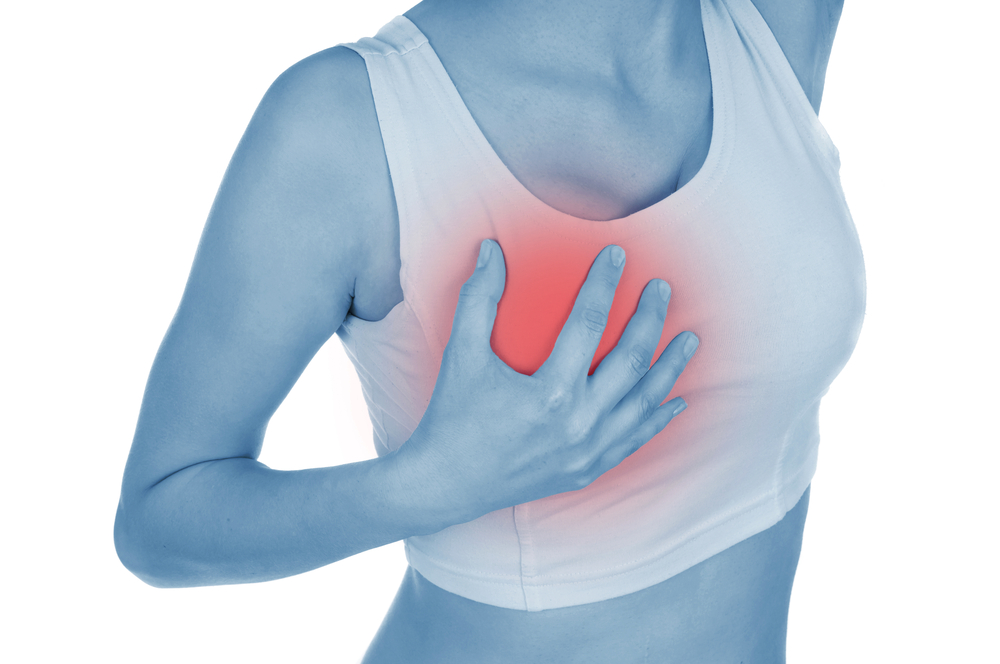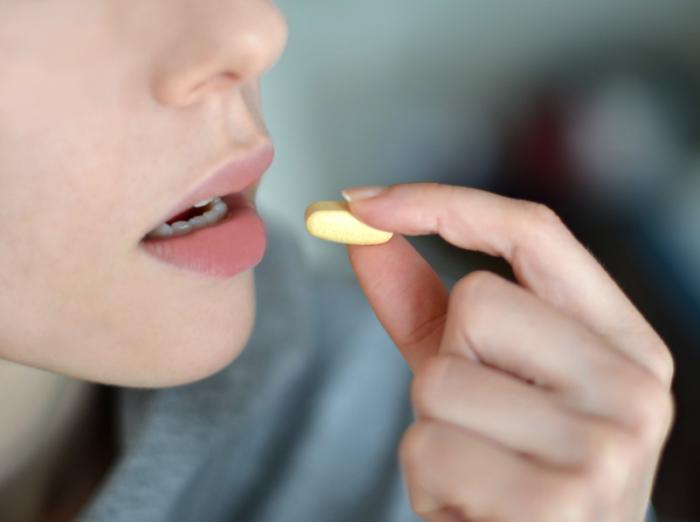Acute mastitis is characterized by the development of the inflammatory process in the tissues of the mammary gland. The disease is manifested by intense and severe bursting pain in the chest, its compaction, swelling, redness of the skin, a sharp rise in temperature, febrile syndrome. Mastitis is diagnosed during examination by a mammologist, an ultrasound of the mammary glands is additionally performed, and if necessary, a mammography. The pathological process can lead to the formation of phlegmon, abscess, necrosis in the affected gland, the development of sepsis and, in some cases, even death. In the case of bacterial contamination of milk, breastfeeding must be stopped. In the future, deformation of the mammary gland may develop, the likelihood of developing mastopathy and oncological tumors in the breast increases.

Breast infection
Acute mastitis occurs mainly due to infection of the mammary gland with bacteria. Pathology is manifested by swelling of the chest, a strong increase in size, soreness and increased sensitivity, flushing of the skin and fever.
The incidence of mastitis in nursing mothers varies from 1 to 16%. The average indicator is 5% of women, and measures to reduce the incidence in recent years are ineffective. The vast majority of patients with mastitis are primogenous women or breastfeeding for the first time. This is due to the highest incidence of milk stagnation due to inept pumping.
Women after thirty years who are not breastfeeding for the first time, in most cases get mastitis due to a decrease in the protective properties of the body, due to the presence of one or another concomitant chronic disease. In such cases, pathological symptoms are accompanied by manifestations of the underlying disease.

Reasons for development
Usually, the occurrence of acute mastitis is due to staphylococcal infection. But if a woman has another source of bacterial flora (infections of the oral cavity, respiratory system, urinary tract, reproductive organs), mastitis can be triggered by these foci. Sometimes the mammary glands become infected with E. coli. The causative agent enters the breast tissue with blood flow, as well as through the milk ducts.
The most common cause of acute lactational mastitis is prolonged pathological lactostasis (stagnation of milk in the gland). In the absence of an outflow of milk from any duct of the mammary gland, a favorable environment is formed for the growth and reproduction of pathogenic bacteria. Actively developing infection causes an inflammatory reaction, suppuration of tissues, febrile syndrome. The patient may feel bad at the same time - severe weakness, intoxication, and in some cases vomiting, nausea are observed.
Classification of acute mastitis
Mastitis is a pathological process that always proceeds in an acute form. The disease is divided into types according to the nature of the developing inflammatory process: infiltrative, serous, purulent, gangrenous, abscessed and phlegmonous. The infiltrative, serous and purulent types of mastitis are stage-by-stage stages of a single inflammatory process in the tissues of the gland - from the formation of a condensed area of serous inflammation to the formation of infiltrate and the beginning of a purulent process.
Abscess form
With an abscessed acute form of mastitis, the foci of suppuration are localized and clearly limited. Phlegmonous mastitis is characterized by the spread of a purulent process in the tissues of the mammary gland. With a prolonged course or a weakened immune system, the affected tissue of the gland begins to necrotize, and the gangrenous stage of mastitis begins.

Some clinical varieties of mastitis are also distinguished, the most common of which are: acute lactation, which occurs in the postpartum period, mastitis of newborns and plasma cell.
Symptoms
Acute mastitis is in most cases a complication of lactostasis of inflammatory etiology in nursing mothers. In some cases, the disease develops without previous expressed symptoms of milk stagnation. The disease is manifested by painful compaction in the mammary gland, hyperemia and hyperthermia of the skin in the area of compaction. The patient has fever and general symptoms of intoxication. With the progression of the disease, the pain intensifies, the gland increases, it becomes hot and dense to the touch. Breastfeeding and expressing milk in this condition is sharply painful. Together with milk, blood and pus can be released. Acute purulent mastitis often progresses with the formation of an abscess of the mammary gland.
In non-breastfeeding women
There is also acute mastitis in a non-breastfeeding woman. We will talk about treatment below. Such cases belong to a pathology such as plasma cell mastitis, a rare disease that develops in older women who have given birth repeatedly after the lactation period has ended. The pathological process is characterized by tissue infiltration under the nipple by plasma cells and hyperplasia of the epithelial tissues of the excretory ducts. Acute mastitis of this form is not suppurated and has similar features with breast cancer.
Mastitis of newborns is a phenomenon in children of both sexes that occurs quite often. It is manifested by engorgement of the mammary glands and transparent secretions during pressure on them. This pathology, as a rule, is a consequence of the residual effect of maternal sex hormones. With the development of acute non-lactational mastitis and the formation of an abscess, surgical purification of the purulent focus is performed, but most often the symptoms of mastitis in newborns subside on their own after a few days.
Diagnostic measures
The focus of the inflammatory process in the mammary gland is diagnosed by palpation. In addition, a woman has an increase in axillary lymph nodes on the side of the affected gland (sometimes mild pain on palpation). Suppuration is characterized by the definition of a sign of fluctuation.
Ultrasound of the mammary glands visualizes a typical picture of the inflammatory process. Mastitis of the serous type is characterized by a smoothed echographic picture of the structures of the gland, thickening of the skin, expansion of the milk ducts and subcutaneous tissue. Infiltrate in the gland looks like a clearly defined limited area of reduced echogenicity, with further progression, a picture of “honeycombs” is revealed. In addition, with ultrasound, the development of abscesses is well visualized and necrotic zones are determined. The reliability and specificity of this method reaches 90%.

Since the diagnosis of acute mastitis usually does not cause difficulties, mammograms are usually not performed. With a questionable picture on an ultrasound, an aspirate is taken for histological examination (aspiration, fine-needle biopsy of the mammary gland under ultrasound control). For bacteriological research, specialists can take milk from the affected mammary gland.
With a sluggish course of the inflammation process and due to the formation of fibrous tissue around it (foci of the focus), they speak of the transition of the pathology to a chronic form. In this case, clinical symptoms are usually mild, but palpation is diagnosed as a sedentary dense roller, soldered to the skin. Next, we talk about the treatment of acute mastitis.
Therapy
At the slightest suspicion of the development of acute mastitis, it is urgent to contact a mammologist, since in the treatment of this pathology it is important to timely identify and take measures to eliminate the causes of mastitis and inhibit the infection process. Delaying contacting a doctor or self-medication is unacceptable, since the ailment is prone to rapid progression and the formation of an abscess. In case of purulent mastitis, surgical treatment is necessary.

When diagnosing this disease at the stage of the serous process or the formation of an infiltrate, conservative therapy is performed. The patient is prescribed antibiotics using potent drugs with a wide spectrum of action. In this case, serous mastitis passes after 2-3 days. Resorption of the infiltrate can take up to 7 days in duration. If the patient has severe intoxication during inflammation, she is shown detoxification measures (glucose infusion, electrolyte solutions). With excessive lactation, funds are prescribed to suppress it.
What else is the treatment of acute mastitis. A purulent form of the disease, as a rule, requires surgical intervention. The developed abscess of the gland is a direct indication for urgent surgical debridement - mastitis is opened and the purulent focus is drained.
Contraindication to breastfeeding
Progressive forms of mastitis, regardless of the stage of the disease, are a direct contraindication to further breastfeeding (even healthy breasts), since milk contains infectious pathogens and toxic elements of tissue breakdown. For a child, such nutrition can cause dysbiosis and disorders of the functional state of the digestive tract. Since the treatment of mastitis involves the use of antibiotics, feeding during this period is also unsafe for babies. Antibiotics can significantly harm the normal development of organs and tissues. During the treatment of mastitis, milk can be expressed, pasteurized, and then feed the baby to it.
Indications for the suppression of lactation are: the absence of positive dynamics with infiltrative and serous mastitis for 3 days of antibiotic therapy, the transition of the disease into a purulent form, concentration of the focus of infection directly under the nipple, purulent mastitis in the past, concomitant systemic pathologies that significantly worsen a woman's well-being.

Possible complications
Any infectious process caused by staphylococcus can be complicated by the generalization of infection and the occurrence of septic complications:
- meningoencephalitis or meningitis;
- bacterial pericarditis or endocarditis;
- sepsis (the presence of multiple foci of infection - pneumonia, osteomyelitis, etc.);
- DIC;
- infectious toxic shock.
Complications of acute mastitis can be life threatening.
Prevention
Preventive measures are combined with measures to prevent lactostasis, since such a condition precedes mastitis in the vast majority of situations.
For the prevention of congestion in the mammary gland, thorough emptying of the breast is necessary: regular feeding and further decantation of milk residues. In the case when the baby has enough milk from one breast, at the next feeding it must be applied to another mammary gland.

The main preventive measure to prevent mastitis is the timely diagnosis and rehabilitation of any infectious foci in the body, but it should be understood that systemic antibiotic therapy during lactation is strictly contraindicated.
Prevention is of particular importance in the postpartum period, especially if the woman gave birth for the first time. The milky ducts and nipple are not yet prepared for breastfeeding, therefore, it is necessary to consult a mammologist on time and take measures to eliminate stagnation of milk. A good way to prevent lactostasis is to massage the breast in the first days after birth. At the same time, the glands are painful, have a dense structure, and an elevated skin temperature, but even so, regular pumping of breast milk and massage are recommended.